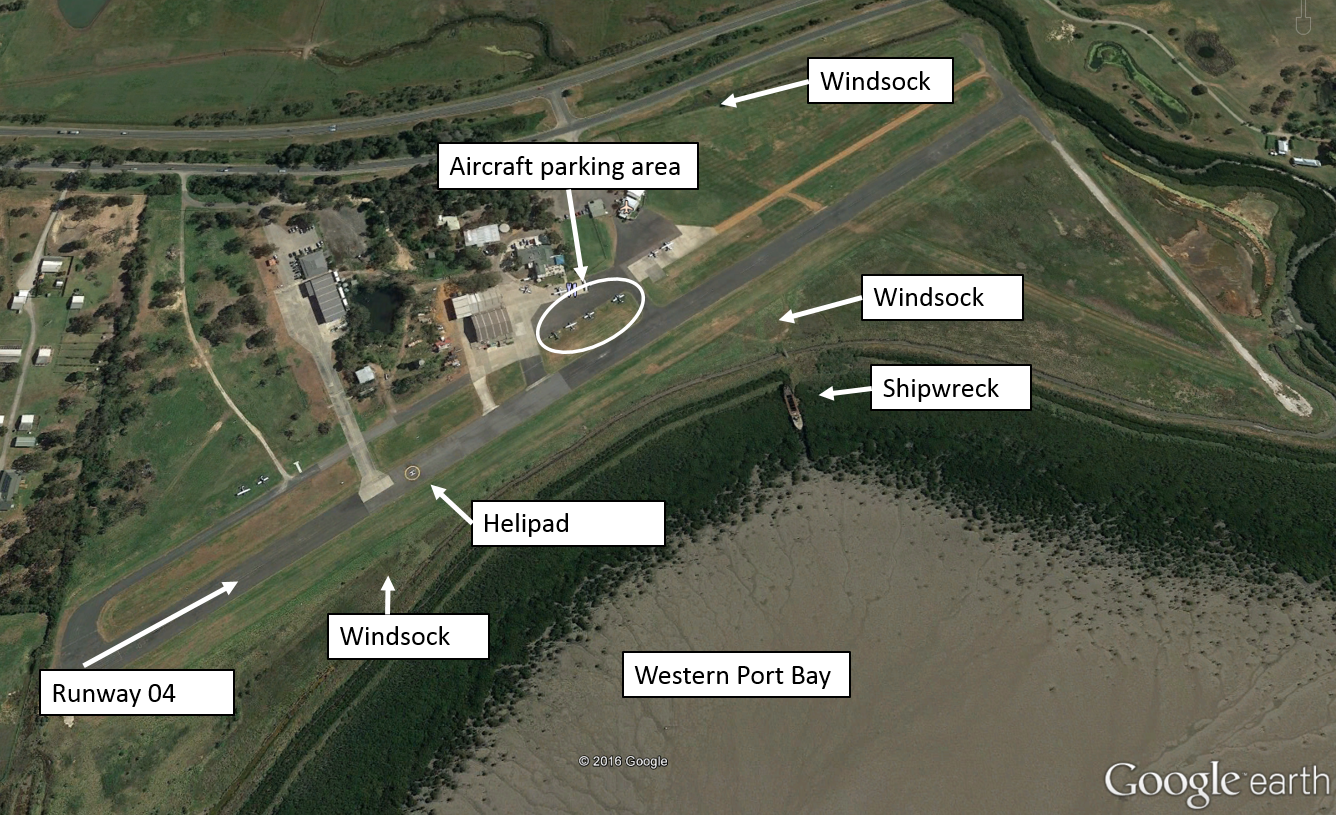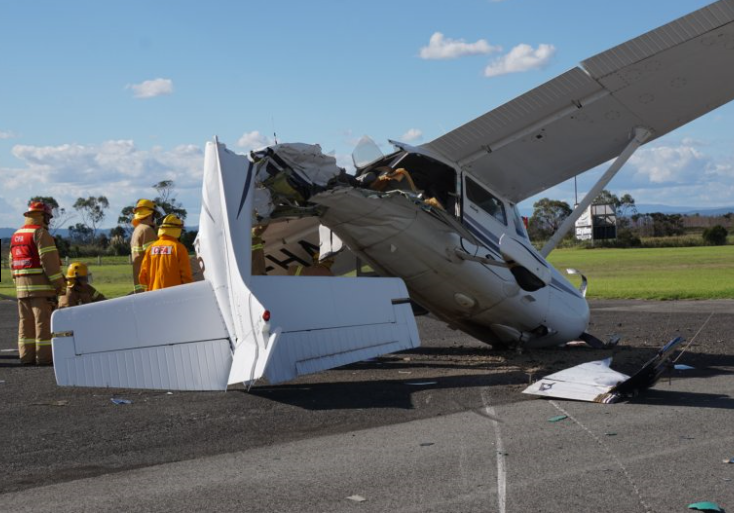What happened
On the morning of 20 March 2016, the pilot of a Cessna 182S aircraft, registered VH-PCO, conducted a private flight from Moorabbin Airport to Tooradin Airfield,[1] Victoria, with two passengers on board. The aircraft took off from runway 17 Right at Moorabbin, and the wind during the 21 NM flight was south-easterly at about 10 kt. The runway in use at Tooradin was 04 (Figure 1), and the pilot reported that the landing at the end of that flight was uneventful.
Figure 1: Tooradin Airfield

Source: Google earth, annotated by the ATSB
After landing at Tooradin, the pilot prepared to conduct a scenic flight to Wonthaggi, Wilsons Promontory and return, with three passengers on board. While on the ground at Tooradin, the pilot was concerned that the wind had increased since their arrival, therefore obtained an updated weather forecast and the actual weather at Tyabb, which was about 12 NM south-west of Tooradin. The pilot also obtained the latest weather report for Moorabbin, where the wind was from 120° at 11 kt, and runway 13 was in use.
Based on that information, the pilot assessed that it was suitable to go ahead with the planned flight, but also made the contingency plan to divert to Moorabbin if the strength of the crosswind at Tooradin was not suitable for a landing on their return.
The pilot reported that the flight was normal. At about 1320 Eastern Daylight-saving Time (EDT), the aircraft returned to Tooradin, and the pilot elected to join the circuit on a right downwind for runway 04. While on the downwind circuit leg, the pilot and the front seat passenger observed a windsock, which was located near the runway 04 threshold (near the helipad). The pilot stated that the windsock indicated that the wind was blowing straight down the runway, and elected to continue the approach.
After turning onto final approach, the pilot selected full flap (40°). When at about 300 ft above ground level, the pilot confirmed that the windsock still indicated a headwind, and continued the approach. The pilot reported that as the main wheels touched down, about 300 m beyond the runway threshold, the aircraft veered left off the runway onto the grass.
The pilot immediately commenced a go-around by applying full power and raising the aircraft’s nose in an attempt to clear aircraft parked on the grass ahead. The stall warning horn sounded, and the pilot assessed that the aircraft was not climbing and that its landing gear may collide with the parked aircraft.
The pilot therefore reduced the power to idle and the aircraft landed heavily to the north of the runway. The aircraft then struck three other aircraft that were parked on a grassed area between the runway and a sealed taxiway.
The aircraft sustained substantial damage and the pilot and passengers were uninjured (Figure 2).
Figure 2: Accident site showing damage to VH-PCO

Source: Country Fire Authority Victoria
Pilot experience and comments
The pilot had a total of 168.8 hours of aeronautical experience, including 5.4 hours in the Cessna 182S.
The pilot provided the following comments:
- Prior to the flight, the pilot assessed the wind using the windsock to the north of the field and the torn windsock near the shipwreck. On final approach, the pilot referenced the windsock near the runway 04 threshold (near the helipad).
- In hindsight, they should have retracted the flaps to 20° for the go-around.
- There was no indication of a crosswind during the approach.
Weather observations
There was no automatic weather station at Tooradin. The nearest weather data recorded by the Bureau of Meteorology was at Moorabbin and Frankston, and the ATSB obtained the 1-minute weather data for those locations. The runway at Tooradin was situated adjacent to Western Port Bay, and the runway direction in use was 04. The pilot and an instructor at Tooradin reported that the wind at Tooradin was generally not the same as that experienced at Moorabbin.
Around the time of the accident, the wind at Frankston was varying in direction from 096° to 143°, from 6 to 10 kt, gusting to 15 kt. An instructor at Tooradin reported that throughout the day, the wind was about 7 to 9 kt, some of which was crosswind, as it was blowing at about a 45° angle to the runway.
The instructor also reported that the main windsock for the airfield was to the north of the field, and there were two windsocks on the southern side of the strip – one located near the helipad and the other, which was torn but still indicating accurately, adjacent to the shipwreck (Figure 1).
Safety action
Whether or not the ATSB identifies safety issues in the course of an investigation, relevant organisations may proactively initiate safety action in order to reduce their safety risk. The ATSB has been advised of the following safety action in response to this occurrence.
Aircraft operator
Although the accident flight was a private flight, the aircraft operator, as a training organisation, has advised the ATSB that as a result of this occurrence, they are taking the following safety actions:
Improving the delivery of training in crosswind circuits and go-arounds
The aircraft operator is reviewing
- what grade instructors are authorised to conduct training in crosswind conditions
- which aerodrome the lessons are delivered at
- the minimum crosswind component for the lessons
- where it is delivered within the training syllabus
- the contents of training notes and sequence briefing
- how they allocate testing officer to ensure there is no student input.
The operator has also asked flight testing officers to emphasise crosswind and go-around techniques.
Presentation to company pilots
The operator has arranged for a senior airline captain to deliver a presentation to company pilots on stabilised approaches, selection of the touchdown zone, and appropriate responses to non-normal situations.
Carriage of airsick bags
Aircraft folders will be equipped with airsick bags, to reduce the effect a sick passenger may have on a pilot’s workload.
Review of Emergency Response Plan
While the operator assessed that their emergency response plan was effective in this incident, they have identified some improvements to be implemented.
Safety message
A report prepared by the US Aircraft Owners and Pilots Assocation, Cessna 182 Skylane Safety Highlights, stated that the number of accidents for the aircraft type was inversely proportional to the number of hours a pilot had accumulated, and the majority of accidents involved pilots with less than 400 hours’ total time. Landing was the most accident-prone phase of flight. The report also stated that the maximum demonstrated crosswind component for most Cessna 182 aircraft was 15 kt – most pilots should consider that as limiting until they are highly proficient in crosswinds. The aircraft’s Pilot Operating Handbook suggested procedures for landing in crosswinds, including that they should be performed with the minimum flap setting necessary for the field length.
The Flight Safety Foundation Approach-and-landing accident reduction tool kit Briefing note 6.1 – Being prepared to go around, stated that the importance of being go-around-prepared and go-around-minded must be emphasised because a go-around is not a frequent occurrence.
Aviation Short Investigations Bulletin - Issue 49
Purpose of safety investigationsThe objective of a safety investigation is to enhance transport safety. This is done through:
It is not a function of the ATSB to apportion blame or provide a means for determining liability. At the same time, an investigation report must include factual material of sufficient weight to support the analysis and findings. At all times the ATSB endeavours to balance the use of material that could imply adverse comment with the need to properly explain what happened, and why, in a fair and unbiased manner. The ATSB does not investigate for the purpose of taking administrative, regulatory or criminal action. TerminologyAn explanation of terminology used in ATSB investigation reports is available here. This includes terms such as occurrence, contributing factor, other factor that increased risk, and safety issue. Publishing informationReleased in accordance with section 25 of the Transport Safety Investigation Act 2003 Published by: Australian Transport Safety Bureau © Commonwealth of Australia 2016
Ownership of intellectual property rights in this publication Unless otherwise noted, copyright (and any other intellectual property rights, if any) in this report publication is owned by the Commonwealth of Australia. Creative Commons licence With the exception of the Coat of Arms, ATSB logo, and photos and graphics in which a third party holds copyright, this publication is licensed under a Creative Commons Attribution 3.0 Australia licence. Creative Commons Attribution 3.0 Australia Licence is a standard form licence agreement that allows you to copy, distribute, transmit and adapt this publication provided that you attribute the work. The ATSB’s preference is that you attribute this publication (and any material sourced from it) using the following wording: Source: Australian Transport Safety Bureau Copyright in material obtained from other agencies, private individuals or organisations, belongs to those agencies, individuals or organisations. Where you wish to use their material, you will need to contact them directly. |
__________


